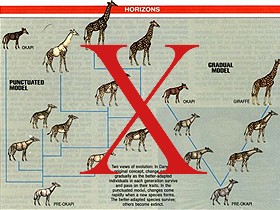This model began with great fanfare by two American paleontologists, Niles Eldredge and Stephen Jay Gould, in the 1970s. These two evolutionist scientists were aware that the claims of neo-Darwinian theory were totally refuted by the fossil record. Fossils proved that living things had not appeared on Earth through gradual evolution, but had appeared suddenly and perfectly formed. Neo-Darwinists were living with the hope that the fossils they sought would one day be found-which indeed is still the case today. But Eldredge and Gould realized that this hope was unfounded. Since they were unwilling to abandon the dogma of evolution, they therefore proposed a new model; punctuated evolution, the claim that evolution occurred not with small, gradual changes, but in very large sudden ones.
This was actually a fantasy model. For example, Otto Schindewolf who had preceded Eldredge and Gould, had given a conjectural example of punctuated evolution, claiming that the first bird in history emerged from a reptile egg through a gross mutation-some giant, random mutation in its genetic structure.197 (See The Macro-Mutation Deception.) According to the theory, certain terrestrial animals might have turned into giant whales as a result of sudden and comprehensive changes, within a single generation. These claims conflict with all known genetic, biophysical and biochemical laws, and were about as scientific as tales of princes turning into frogs. But some evolutionist paleontologists, troubled by the crisis facing the claims of neo-Darwinism, clung to this theory even though it was even more nonsensical than neo-Darwinism itself.
This theory's sole aim of was to account for the fossil gaps that the neo-Darwinist model was unable to explain. However, it is completely irrational to explain away the fossil gaps by claims along the lines that "Birds suddenly emerged from reptile eggs." For any species to evolve into another, there must be a very large and beneficial change in its genetic data. Yet no mutation can develop genetic information or add any new data to it. Mutations lead solely to a loss of, or damage to, existing data. The wholesale mutations imagined by the adherents of punctuated evolution would actually represent reductions and defects in genetic information.
 The two famous advocates of the punctuated model of evolution; Stephen Jay Gould and Niles Eldredge. |
Like the neo-Darwinist model, the punctuated evolution model collapses at the outset when faced with the question of how the first living thing came into existence. Since a single protein cannot come into being by chance, organisms composed of trillions of proteins cannot emerge in a punctuated or gradual manner.
At present, the punctuated evolution theory maintains that living populations exhibit no changes for long periods of time, remaining in a kind of equilibrium. According to the claim, evolutionary changes take place in very brief spaces of time among very narrow populations. (Equilibrium is thus interrupted, or "punctuated.") Since the population is so very small, mutations are quickly chosen by way of natural selection, and the emergence of new species is thus made possible.
According to this theory, a reptile species can survive for millions of years without undergoing any changes. However, one small group of reptiles that somehow separates away from the others is subjected, in a manner that is not explained, to a series of intense mutations. The group evolves rapidly and soon turns into a new reptile species, or maybe even into mammals. Since this process takes place very quickly within a narrow population, very few fossil traces, if any, are left behind.
Close inspection shows that this theory was proposed to answer the question, of "How can evolution progress so fast as to leave no fossil trace behind?" In developing an answer, two fundamental assumptions are made:
- That macro-mutations, wide-raging mutations that cause major changes in genetic data, provided advantages for living things and produced new genetic information. (See The Macro-Evolution Deceit.)
- That narrow animal populations are genetically advantaged. (See Narrow Population.)


